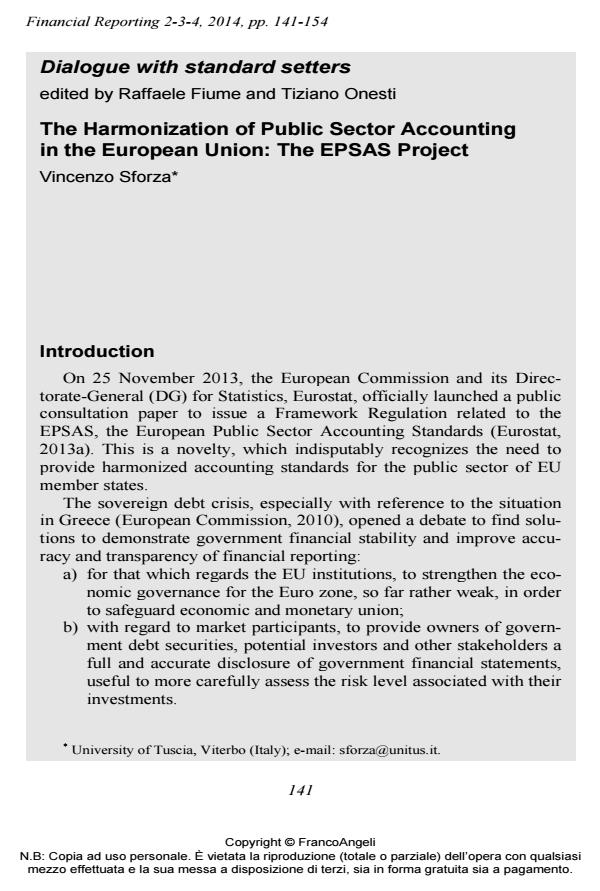Dialogue with standard setters
Titolo Rivista FINANCIAL REPORTING
Autori/Curatori Vincenzo Sforza
Anno di pubblicazione 2015 Fascicolo 2014/2-3-4 Lingua Inglese
Numero pagine 14 P. 141-154 Dimensione file 220 KB
DOI 10.3280/FR2014-002006
Il DOI è il codice a barre della proprietà intellettuale: per saperne di più
clicca qui
Qui sotto puoi vedere in anteprima la prima pagina di questo articolo.
Se questo articolo ti interessa, lo puoi acquistare (e scaricare in formato pdf) seguendo le facili indicazioni per acquistare il download credit. Acquista Download Credits per scaricare questo Articolo in formato PDF

FrancoAngeli è membro della Publishers International Linking Association, Inc (PILA)associazione indipendente e non profit per facilitare (attraverso i servizi tecnologici implementati da CrossRef.org) l’accesso degli studiosi ai contenuti digitali nelle pubblicazioni professionali e scientifiche
- Eurostat (2013b), Manual on Government Deficit and Debt. Implementation of ESA95, 2013 edition, Publications Office of the European Union, 2013.
- Christiaens J., Reyniers B. and Rollé C. (2010), Impact of IPSAS on reforming governmental financial information systems: a comparative study, International Review of Administrative Sciences, 76 (3), pp. 537-553, DOI: 10.1177/0020852310372449
- Christiaens J. and Van den Berghe M. (2006), The Ernst & Young Guide to Applying IPSAS, die Keure, Kleine Pathoekeweg 3, Brugge.
- Dasí R.M., Montesinos V. and Murgui S. (2013), Comparative Analysis of Governmental Accounting Diversity in the European Union, Journal of Comparative Policy Analysis: Research and Practice, 15 (3), pp. 255-273, DOI: 10.1080/13876988.2013.798117
- Ernst & Young (2012), Overview and comparison of public accounting and auditing practices in the 27 EU Member States, Final Report prepared for Eurostat, 19 December 2012.
- European Commission (2010), Report on Greek government deficit and debt statistics, COM(2010) 1 final, Brussels, 8 January 2010.
- European Commission (2013a), Report from the Commission to the Council and the European Parliament, Towards implementing harmonised public
- sector accounting standards in Member States. The suitability of IPSAS for the Member States, COM(2013) 114 final, 6 March 2013, Brussels, --URL: http://epp.eurostat.ec.europa.eu/portal/page/portal/government_finance_stat istics/government_accounting.
- http://epp.eurostat.ec.europa.eu/portal/page/portal/government_finance_stat istics/government_accounting.
- European Commission (2013b), Commission Staff Working Document, SWD(2013) 57 final, Brussels 6 March 2013, Accompanying the document European Commission (2013), Report from the Commission to the Council and the European Parliament, Towards implementing harmonised public sector accounting standards in Member States. The suitability of IPSAS for the Member States, COM(2013) 114 final, URL: http://epp.eurostat.ec.europa.eu/portal/page/portal/government_finance _statistics/government_accounting.
- Eurostat (2012), Public consultation – Assessment of the suitability of the International Public Sector Accounting Standards for the Member States, Summary of responses, December 2012.
- Eurostat (2013a), Towards implementing European Public Sector Accounting Standards (EPSAS) for EU Member States – Public consultation on future EPSAS governance principles and structures, --URL: http://epp.eurostat.ec.europa.eu/portal/page/portal/lang-en/public_consultations/consultations/epsas.
- Grossi G. and Pepe F. (2009), Consolidation in the public sector: a crosscountry comparison, Public Money & Management, 29 (4), pp. 251-256, DOI: 10.1080/09540960903035031
- IPSASB (2013), Handbook of International Public Sector Accounting Pronouncements,
- 2013 Edition (www.ifac.org). Jones R. (2000), National Accounting, Government Budgeting and the Accounting Discipline, Financial Accountability & Management, 16 (2), pp. 101-116, DOI: 10.1111/1468-0408.00099
- Jones R. (2003), Measuring and Reporting The Nation’s Finances: Statistics and Accounting, Public Money & Management, 23 (1), pp. 21-28, DOI: 10.1111/1467-9302.00337
- Jones R. and Pendlebury M. (2010), Public Sector Accounting (6th Edition). (Harlow, England: Pearson Education Limited, Financial Times Prentice Hall).
- Mechelli A. (2009), Accounting Harmonization and Compliance in Applying IASB Standards: An Empirical Survey about the First Time Adoption of IAS 7 by Italian Listed Groups, Accounting in Europe, 6 (2), pp. 231-270, DOI: 10.1080/17449480903172077
- Pozzoli M. (2005), Principi contabili ed enti locali. La prospettiva internazionale. (Milano: FrancoAngeli).
- Sutcliffe P. (2003), The Standards Programme of IFAC’s Public Sector Committee, Public Money & Management, 32 (1), pp. 29-36, DOI: 10.1111/1467-9302.0033
Vincenzo Sforza, Dialogue with standard setters in "FINANCIAL REPORTING" 2-3-4/2014, pp 141-154, DOI: 10.3280/FR2014-002006